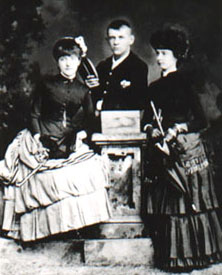
1856-1865

|
1856
|
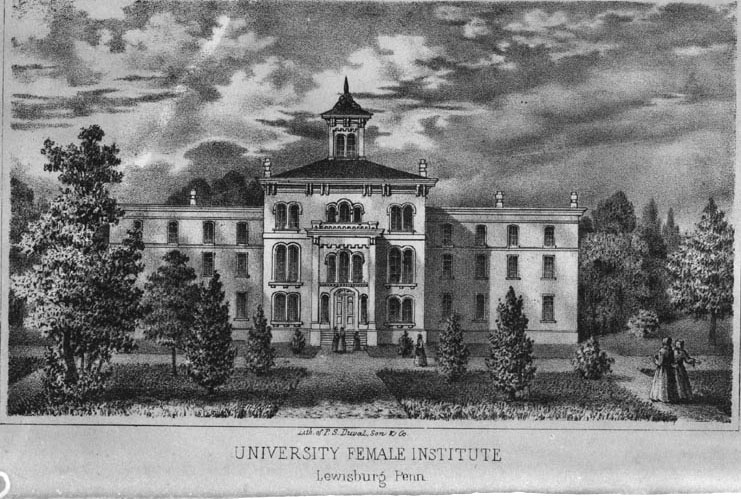 |
Trustees report that the Female institute was still prospering, making a profit, and becoming full to overflowing and agreed that a larger and better building for the Institute was "absolutely necessary." On November 1, the University awards the contract for a new building to house the Female Institute to L.B. Root & Co, of Muncy for $16,500. Situated in "the Grove near St. George street," the facility "will comfortably accommodate 90 pupils with their teachers." The kitchen, dining hall, and school rooms were large enough to permit an addition of enough sleeping apartments to accommodate up to 150 boarders. The building was to be ready for occupancy on September 20, 1857. This year the University also emerges safely from the danger of removal that had existed from the University's persisting poverty. Oliphant |
|
1857
|
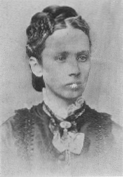
|
Amanda Taylor reports to the Bucknell trustees that the extra teacher she requested, Harriet E. Spratt, who graduated in 1855 from the Female Institute, "has proved herself a worthy and competent teacher, for so recent a graduate, and by her unremitting and laborious efforts she has given entire satisfaction to all parties." Spratt trains under Amanda Taylor and Lucy Rundell until 1870 when she is promoted to principalship. Theiss |
|
1857
|
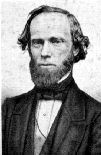 |
George Ripley Bliss becomes Acting President of the University at Lewisburg. Oliphant |
|
1858
|
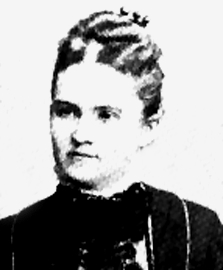 |
Sarah (Sallie) Emily Chamberlin graduates from the Female Institute. She works as a volunteer nurse during the Civil War. She marries Lt. Charles Frederick Eccleston, a friend of her brother's, in 1866 and has a son, John, and a daughter, Emily. Following her husband's death in 1875, Sallie wages a bitter battle with her family when she announces that she intends to take training to become a kindergarten teacher to support herself and her children. After training in Philadelphia, she goes to Winona, Minnesota in 1880 to open a kindergarten at the normal school. In 1883, she sails to Argentine with her 14-year-old daughter and begins her educational work there. She becomes the founder of public kindergartens on the pampas long before they were established in many cities in the States. She works in the kindergartens day in and day out for 30 years and trains six school generations of Argentine women to teach in them. By her death in 1916, she is known in Argentine as "the grandmother of kindergartens." In Buenos Aires, a kindergarten and grade school carry her name, Escuela Sara Chamberlin Eccleston. Luiggi |
|
1859
|
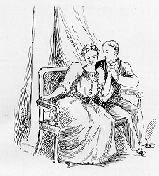 |
"Practically all mingling of the two sexes was forbidden, except that men students might make formal calls on Friday evening in the Institute parlors - where teachers prowled watchfully. For years after the Institute was moved to the campus, a high board fence surrounded the Institute building, with a thick hedge of arbor vitae within, to prevent men from even seeing the Institute building; and the lower halves of first floor windows in the building were whitened so that girls could not even catch a glimpse of a passing male. Women students were not permitted to go into town alone, even at midday. One of the early suggestions of the Principal of the Institute to the Board was that they pass a rule that when women students went into town they must be accompanied by a woman teacher who had had at least six years experience in handling girls! The trustees passed the rule." Theiss |
|
1860
|
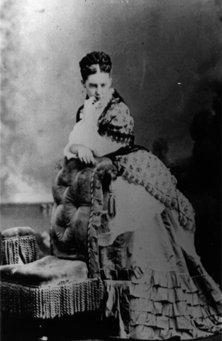 |
Miss Lucy Bliss graduates from the Female Institute. The oldest daughter of Dr. George Ripley Bliss, she remembers that runaway slaves were assisted at the barn on her family's property. She "well remembers making up beds in this barn for fugitive Negroes, with bedding kept for that purpose. So dangerous was it to harbor runaway slaves that she never knew whence they came or whither they went. Mostly these fugitives traveled at night, usually concealed under a load of hay or other material." An historic sign now marks the location of the carriage house on University Avenue where slaves hid. Theiss |
|
1860's
|
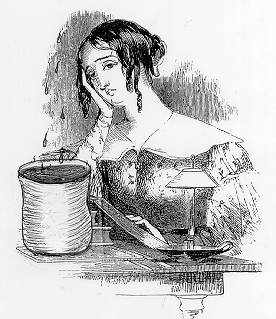 |
This is a difficult period for the University which is in debt and suffering from decreased enrollments. The teachers were presenting demands for additional salaries and the roofs of both the Institute and Old Main leaked badly. A group was appointed to investigate: "The Committee on visiting the Seminary during a heavy rainstorm one night found tubs filled with drippings, and bonnets and clothes ruined, and the matron in despair. . . and many rooms in the Institute could not be occupied at all." The committee made temporary repairs but materials were scarce due to the war. Theiss |
|
1863
|
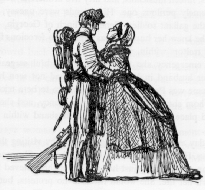 |
On June 15 a dispatch is received which reads "Lee's rebel cavalry are making a raid into Pennsylvania. The militia are called out." The male students resolve to go, and the next day is spent preparing. The next morning "about nine o'clock, the volunteers form in the streets of the town, and amid blessings and tears march to Montandon. All the girls of the town, as well as the Bucknell Institute girls, walk to Montandon to see the boys off. "Many parents, becoming alarmed by the danger from the Confederate invasion, had called their daughters home, so that by this time . . . there were only seven boarders at the Institute. It looked as though there would not be a commencement. The girls thought and talked constantly of what they would do if Lee's army came this way; where they would bury their valuables; who would have an empty cistern where their things could rest secure during the invasion." Theiss The institution closed its doors for the only time in its history in July when the Confederate invasion threatened Pennsylvania; professors and students marched off in an emergency company which played its part in checking the advance of the southern troops. They returned to their class-rooms after Lee's retreat. Bucknell University Catalogue 1924-1925 |
|
1864
|
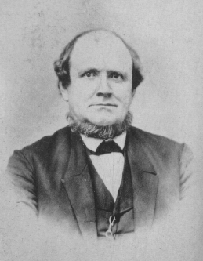 |
The Rev. Mr. Tustin, a university trustee, writes to the board, "Of reports current in this community affecting unfavorably the welfare of the Female Seminary, the most serious appears to be a personal difference between the Principal of the Institute (Miss Amanda Taylor) and the Pastor of the Baptist Church (Rev. S. H. Mirick), prejudicial in its influence to the religious interests of the school." Although the investigating committee does not recommend action at this time, general agent for the University Adie K. Bell will later move that "A committee of three be appointed to inquire and report to the Board as to the expediency of a change of Principal in the Female Institute." This suggestion was followed shortly by the resignation of Miss Taylor and Miss Lucy Rundell succeeds her as Principal. *photo of Adie K. Bell Theiss |
|
1864
|
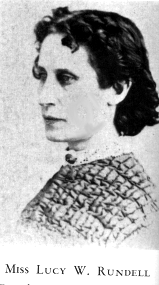 |
Lucy Rundell succeeds Amanda Taylor as one of the early principals of the Female Institute. She serves in this position until 1870 when Harriet E. Spratt is promoted to principalship. In 1866, Bucknell students make a move toward athletic exercise. Miss Rundell, new Institute Principal at this time, introduces a course in gymnastics. She requires all boarding women pupils to take lessons, insisting the effect is good upon the their health. The report made about this course is probably what spurs the Bucknell male students to go in for gymnastics as well. Theiss |
|
1864
|
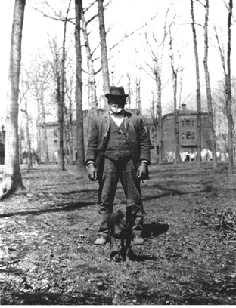 |
Charles Bell, a former slave, served as a custodian for the Female Institute for many years. Bell ran away from his master, with his wife, before the war. They reached Canada by way of the Underground Railway. After the war, Bell visited his 'mammy' back in the South then headed for Williamsport, Pa., where he had noted, in passing through, the great lumbering activity. President Loomis saw him walking through the campus with an axe on his shoulder. Needing a tree felled, he hired the sturdy Negro. Bell remained on the campus until he died. Theiss |
|
1865
|
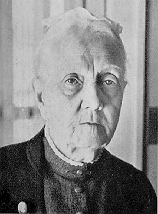 |
Miss Harriet Mason Stevens, an 1858 graduate of the Female Institute, returns to Burma where she was born, with her husband Edward Oliver Stevens, son of a Burma missionary. There they work for the American Baptist Mission Board. Mrs. Stevens helps Burmese girls with their schooling and translates the Bible into the Burmese language. In 1945, at the age of 103, she is the oldest living graduate of Bucknell. Theiss |